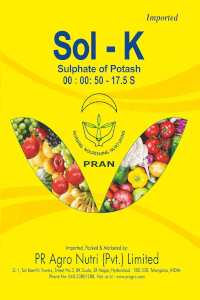Sulphur
In India sulphur is becoming more of a limiting nutrient in crop production than in the past, for several reasons: higher crop yields require more S; increased use of high analysis fertilizers containing little or no S; reduced amounts of atmospheric S fallout from the sky; and reduced soil S reserves from organic matter losses due to mineralization and erosion. Most S in the soil is tied up in organic matter and cannot be used by the plant until it is converted to the sulfate (SO4) form by soil bacteria, which is known as mineralization. Sulphur can be applied as broadcast or banded fertilizer material or applied through irrigation systems (furrow and sprinkler). Sulphur is also an important nutrient for proper nutrition of forage crops that will be consumed by livestock.Sulphur in Plants and Sulphur Deficiency
As mentioned above, Sulphur is absorbed primarily in the sulfate form (SO4-2) by plants. It may also enter the leaves of plants from the air as sulphur dioxide(SO2) gas. It is part of every living cell and required for synthesis of certain amino acids (cysteine and methionine) and proteins. Sulphur is also important for photosynthesis and crop winter hardiness. Leguminous plants need sulphur for efficient nitrogen fixation. Sulphur is also important in the nitrate-reductase process where nitrate-nitrogen is converted to amino acids.In the field, sulphur deficiency and nitrogen deficiency are often easily confused. Symptoms of both deficiencies may appear as stunted plants, with a general yellowing of leaves. Sulphur is immobile within the plant and does not readily move from old to new growth. With sulphur deficiency, yellowing symptoms often first appear in younger leaves, whereas with nitrogen deficiency, the yellowing appears on the older leaves first. In less severe situations, visual symptoms may not be noticeable. The best way to diagnose a deficiency is with a plant tissue analysis that includes an assay for both sulphur and nitrogen. sulphur concentrations in most plants should range from about 0.2 to 0.5 percent. Desirable total nitrogen to total sulphur ratios have been considered and range from 7:1 to 15:1. Wider ratios may point to possible sulphur deficiency but should be considered along with actual N and S concentrations in making diagnostic interpretations.
When sulphur is deficient, nitrate-nitrogen may accumulate. This can pose significant health threats to grazing ruminants or those consuming hay high in nitrates. When nitrates accumulate in the plant, seed formation can be inhibited in some crops such as Canola. Balancing sulphur with nitrogen nutrition is important to both plant and animal health. Crops such as hybrid bermudagrass, alfalfa and corn that have a high dry matter production generally require the greatest amount of sulphur. Also, potato and many other vegetables require large amounts of S and have produced best when S is included in the fertilization program. Without adequate S fertilization, crops that receive high rates of nitrogen may develop sulphur deficiencies.

